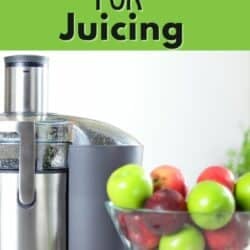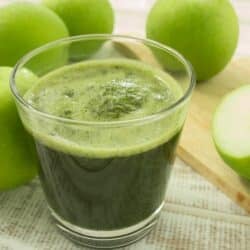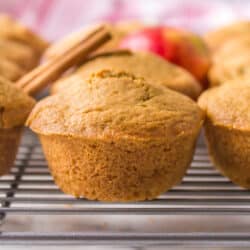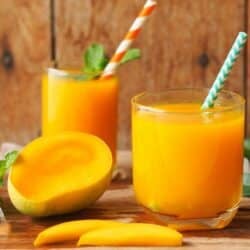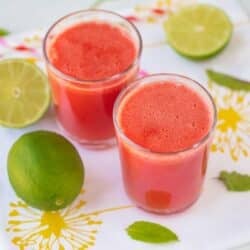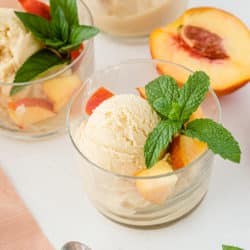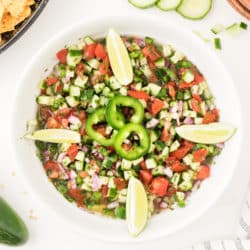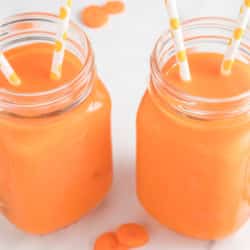7 Best Apples For Juicing (From a Juice Expert)
There are an overwhelming number of apple varieties at the store. Which is best for juicing? Whether you want to make homemade apple juice or a blend of vegetable and apple juice, this article will share which are the best apples for juicing which include Granny Smith, Golden Delicious, Gala, Fuji, Pink Lady, Honeycrisp, and Red Delicious.
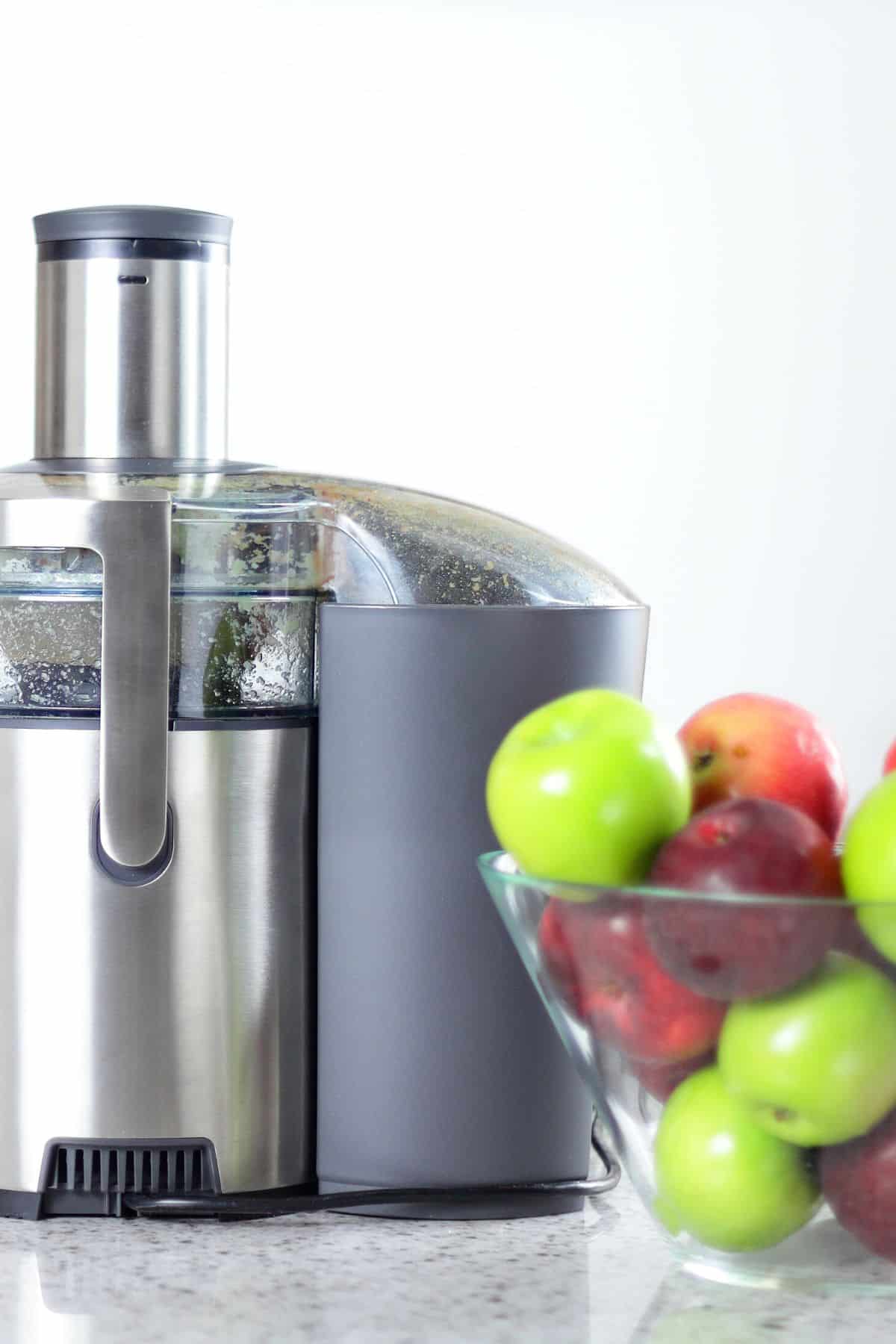
Apple juice is a sweet treat that also has tons of nutritional value.
This refreshing beverage appeals to young and old and comes in various flavor profiles, depending on the apples used for juicing (see my article comparing apple juice versus orange juice).
There are so many exciting varieties of apples at grocery stores, farmers’ markets or the apple orchard for juicing! Apples are grown across North America and the United States, plus many are imported now from countries like New Zealand.
Some different apple varieties are sweet and juicy, some crisp and tart, and others have more complex flavor profiles. But no matter which one gets your tastebuds tingling, all apples can make great apple juice or green juice.
Which Apples Are The Best For Juicing?
Each type of apple has a unique flavor, texture, and various levels of sweetness. It’s best to eat some apples as they are, while others work well for applesauce or for baking.
For juicing, here are some of my favorite apples to make the best juice (for reference, I’ve been juicing for over a decade and consider myself a juicing expert)! See all of my juicing recipes.
1. Granny Smith Apples
These bright green apples have firm flesh, thick skin, and intense apple flavor! They are so crisp and tart that your mouth may pucker when you take the first bite.
Granny Smith apples make the most refreshing juice of all, but it will be a little tart for some tastebuds. Juice it together with some extra sweet apples, and you’ll have some of the best juicing apples.
While green apples are known for being a bit tart, they work perfectly for juicing as they don’t have a high sugar content.
Try these tart apples in my Celery Apple Juice recipe.
2. Golden Delicious Apples
The bright yellow skin on the Golden Delicious suits this apple’s rich and sweet fruity flavor. They are also known as Yellow Delicious apples at the grocery store.
The texture is soft, and the taste is deep, making this apple variety an excellent apple for juicing.
3. Gala Apples
When you get an extra fresh Gala apple, the taste is a little more distinctive, but they generally have a mild fruity flavor.
These apples have a crisp texture and are relatively small, so you’ll have to juice more of them for the same results. They are one of the sweeter apples, but also have a well-balanced acidity.
They’re also easy to find and inexpensive which makes them one of my top picks.
4. Fuji Apples
The robust flavor of Fuji apples makes them great for juicing! They have a fine-grained and firm texture and store really well, so feel free to stock up.
You can combine Fuji apples with others, but they’re so nicely balanced and flavorful that they make delicious juice on their own as well.
For a sweet juice, Fuji apples are my personal favorite and I use them often in my homemade fruit juice recipes. I also love them in vegetable juice because the sweet flavor helps balance the veggie flavor.
5. Pink Lady Apples
These apples are relatively new to the general market and are some of the most flavorful. They have beautiful pink skin, white flesh, and a complex flavor.
Pink Lady apples are sweet and tart and make a delicious and well-balanced juice.
6. Honeycrisp Apples
If you like the idea of your apples tasting a little like honey, you’ll be happy to know that Honeycrisp apples have a distinct honey-like flavor. They have just enough acidity to balance the rich sweetness and are so crispy that they’re almost crunchy!
You can add Honeycrisp apples to any juice or use them alone for that distinctive flavor. They have a slightly tart flavor balanced with a sweet taste.
7. Red Delicious Apples
The Red Delicious apple has a lovely deep red color and a mild, classic apple flavor. It’s simple, refreshing, and sweet with just a hint of tartness.
These red apples are very common which makes them a good apple for the juicing process. They’re also one of the most budget-friendly apples to purchase which also makes them great for using in juice.
This apple is a little mealy if you eat it, so it’s better to juice it.
Bonus Recommendations
There are hundreds of specialty apple varieties available these days. It is unlikely that any of them won’t be appropriate for juicing.
The only thing you might want to take into account is expense. By juicing an apple, you won’t be enjoying the fiber or “wholeness” of the apple. So, you might want to save the expensive heirloom apples for eating out of hand or using in recipes like an apple crisp.
Combining Apples For Flavor and Balance
One of the best things about fresh-pressed apple juice is the delicate balance between sweet and tart flavors. How much of each is needed is up to you.
Some people enjoy tart and refreshing apple juice, while others enjoy slightly sweeter juice.
You can experiment with different apples or try Fuji apples on their own for a well-balanced juice.
I love combining Granny Smith, Gala, and Red Delicious in equal portions to get just the right amount of sweetness and tartness in my apple juice.
Which Apples to Avoid
You should never juice rotten or mildewed apples, as the bacteria may transfer into the juice.
You may also wish to avoid the expensive heirloom apples as the juicing process removes the fiber and some of the flavor.
Other than those two caveats, there aren’t necessarily specific varieties of apples that can’t be juices. Just pick your favorites and start juicing. A lot of the decision about which types of apples to juice is based on personal preference.
Are you ready to start juicing apples!? Here are answers to some FAQs you may have.
Apple Juicing FAQs
For a cup of juice, you’ll need around three medium-sized apples. For a quart of juice, you’ll need 10 to 20 apples. Most apples can produce around a quarter to half a cup of juice.
Fresh apple juice is delicious on its own, but you can add other juices for new flavor combinations and nutritional value. Apple and carrot juice are always winners when you combine them, but you can add any other fruits or veggies you enjoy.
Apple juice is also great in smoothies as a natural sweetener, or you can dilute it with a splash of sparkling water. If you like the idea of using an apple in a smoothie, try this super nutritious Apple Banana Spinach Smoothie recipe.
Both! You can enjoy a refreshing and icy cold glass of apple juice to cool down in summer or have a cup of warm apple juice on a cold day. I love making spiced apple cider by warming the juice up with cinnamon, nutmeg, cloves, allspice, and slices of orange. It’s delicious!
Yes, but some people prefer not to because of the seeds, especially when juicing for small children or people with sensitive digestive systems. Although you’d have to eat more than a hundred apple seeds for it to be a risk, the seeds contain a tiny amount of Amygdalin that is toxic to the digestive system.
The healthiest way to juice apples is to core them but leave the skin on. Most of the apple’s quercetin content is in the peel, and studies show that this flavonoid can help fight the effects of colon cancer!
Apple Juice Benefits
If you haven’t tried freshly juiced apples, you’re in for a treat. It’s a far more flavorful drink than regular, overly processed apple juice.
Don’t Miss These Apple Recipes!
Conclusions
I hope this article gave you some great ideas for which apples to juice to make homemade apple juice. The varieties listed in this article are tried and true winners for making a juice that is tasty and nutritious.
Don’t forget to join my newsletter list to get exclusive clean eating recipes and tips. The newsletter is 100% free with no spam; unsubscribe anytime.
About the Author: Carrie Forrest has a master’s degree in public health with a specialty in nutrition and is a certified holistic nutritionist. She is a top wellness and food blogger with over 5 million annual visitors to her site. Carrie has an incredible story of recovery from chronic illness and is passionate about helping other women transform their health. Send her a message through her contact form.
Note: this post is for informational purposes only and is not intended as medical advice. Please consult your healthcare provider for recommendations related to your individual situation.


